A Day in Cuyahoga Valley National Park – 7 Major Highlights
Situated in northeastern Ohio, Cuyahoga Valley is unique for multiple reasons. Attracting people because of its accessibility, beautiful woodland hikes, cultural importance and historic sites, it is an especially great destination in fall. Moreover, it’s entirely possible to see all major attractions in Cuyahoga Valley National Park in just one day.
Squeezed in between the cities of Cleveland and Akron, this unlikely urban national park receives more than 2.4 million visitors each year.
This makes it one of the most visited national parks in America, more popular, perhaps surprisingly, than more well-known parks like Arches, Everglades and Death Valley.
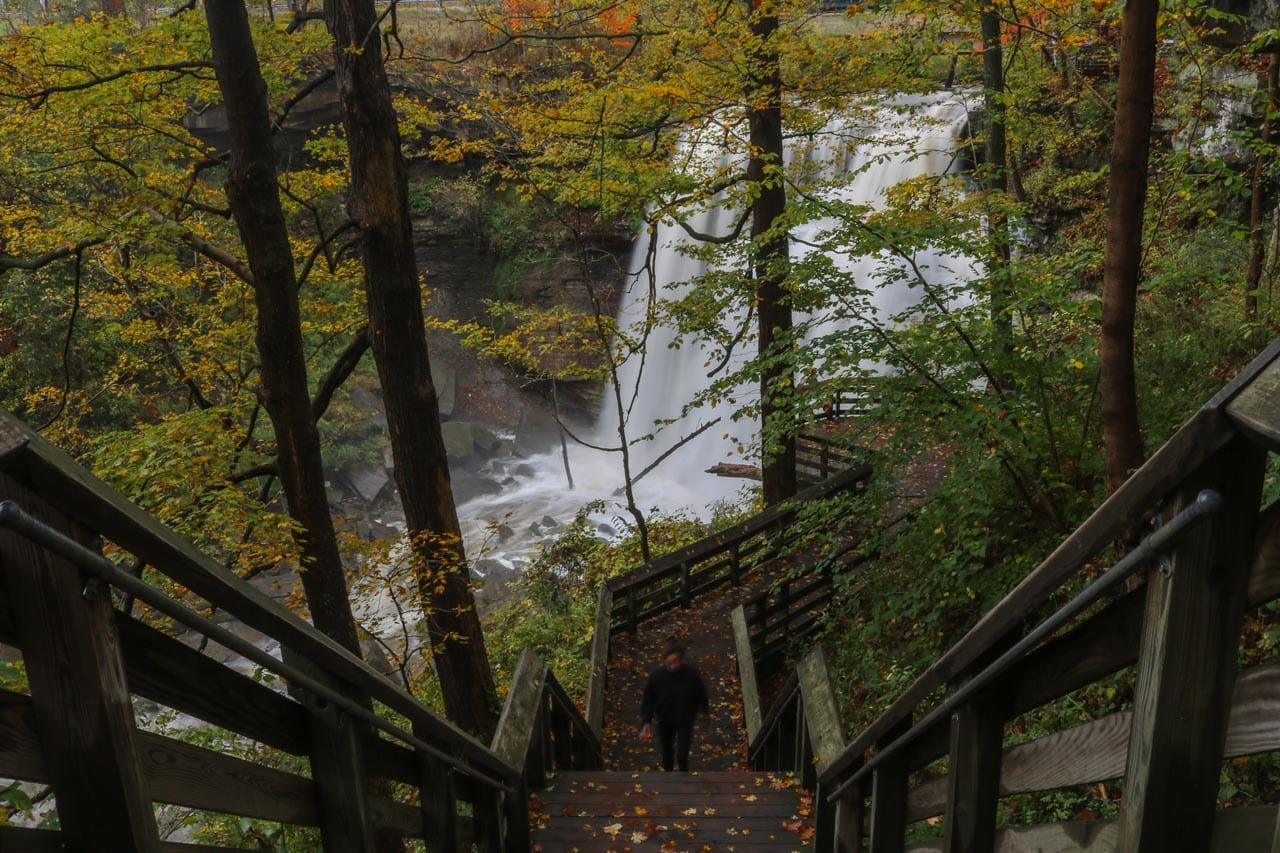
This blog post about the best things to do in Cuyahoga Valley National Park contains affiliate links. You can read more about our Terms of Use / Disclosure here.
A Brief Cuyahoga Valley History
Cuyahoga Valley National Park is by no means a park that’ll blow you away with its spectacular landscapes, but it is a wonderful place to spend a fall weekend.
Protecting an area characterized by forests, waterfalls, old villages and historic transportation routes, it offers a nice combination of both natural and cultural highlights.
The lifeblood of this park flows through the Cuyahoga River. Native Americans used this river as a major transportation route for thousands of years—even designating it neutral territory so everyone could travel safely. After European explorers arrived in the 17th century, news about this fertile valley spread quickly.
Later on, in 1827, the Ohio & Erie Canal was established, connecting Ohio to the rest of the settled United States, particularly the eastern seaboard markets.
Several decades later, the Industrial Revolution called for a more modern mode of transportation, resulting in the construction of a railroad—now known and still in use as the Cuyahoga Valley Scenic Railroad.
After having been a National Recreation Area for several decades, Cuyahoga Valley National Park was designated a national park in 2000. It’s unique in the sense that it’s essentially an urban and cultural park.
It’s not so much about protecting remarkable landscapes than it is about preserving an essential part of American history.
That said, however, there are many Cuyahoga Valley National Park attractions that will impress everyone from hikers to wildlife photographers.
There’s still plenty of wildness left in this area surrounded by the urban sprawl of Cleveland and Akron and flanked by interstates and highways.
More About Cuyahoga Valley National Park
7 Top Attractions in Cuyahoga Valley National Park
The number of highlights and attractions in Cuyahoga Valley National Park may surprise you. There’s more going on than you might expect. This welcoming and easy-to-visit national park has enough going on to keep you busy for a few days.
However, as I say before, you can also hit the best sights in Cuyahoga Valley National Park in only one day. Do make sure, though, that you do set aside enough time. Don’t just visit it as a day excursion from Cleveland, but do spend the night in or just outside the park.
I always recommend people to allow at least—the absolute, very minimum—24 hours for every national park, even the smallest ones. And Cuyahoga Valley is no different.
When I say, “a day in Cuyahoga Valley National Park”, I mean that literally. Keep that in mind, as you will need a full day for the following top things to do in Cuyahoga Valley National Park.
1. Brandywine Falls
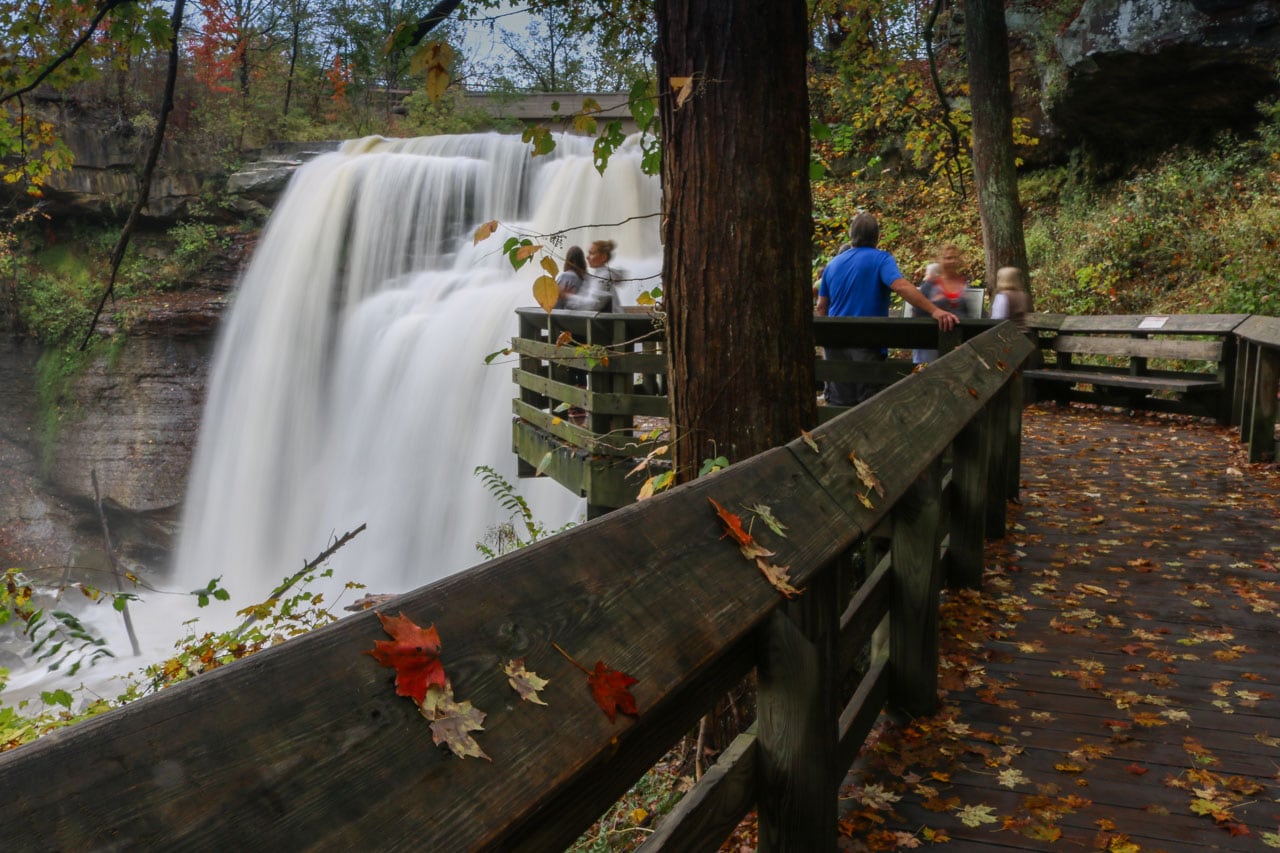
Surrounded by amazing fall foliage, the thundering waters of Brandywine Falls are as spectacular as ever.
This is without a doubt one of the—if not the—top attractions in Cuyahoga Valley National Park, which in turn is one of America’s finest national parks for waterfalls.
This 65-foot (20-meter) waterfall is the centerpiece of the “falls area”, once the site of a village powered by the waterfall’s rushing waters. Later, water power provided energy for industry and, later still, supported an artist’s colony.
You can walk the short boardwalk down to the viewing platform first, but I suggest that you hike the pleasantly moderate 1.4-mile (2.25-kilometer) Brandywine Gorge Loop first, saving this imposing waterfall as a reward.
2. The Ledges
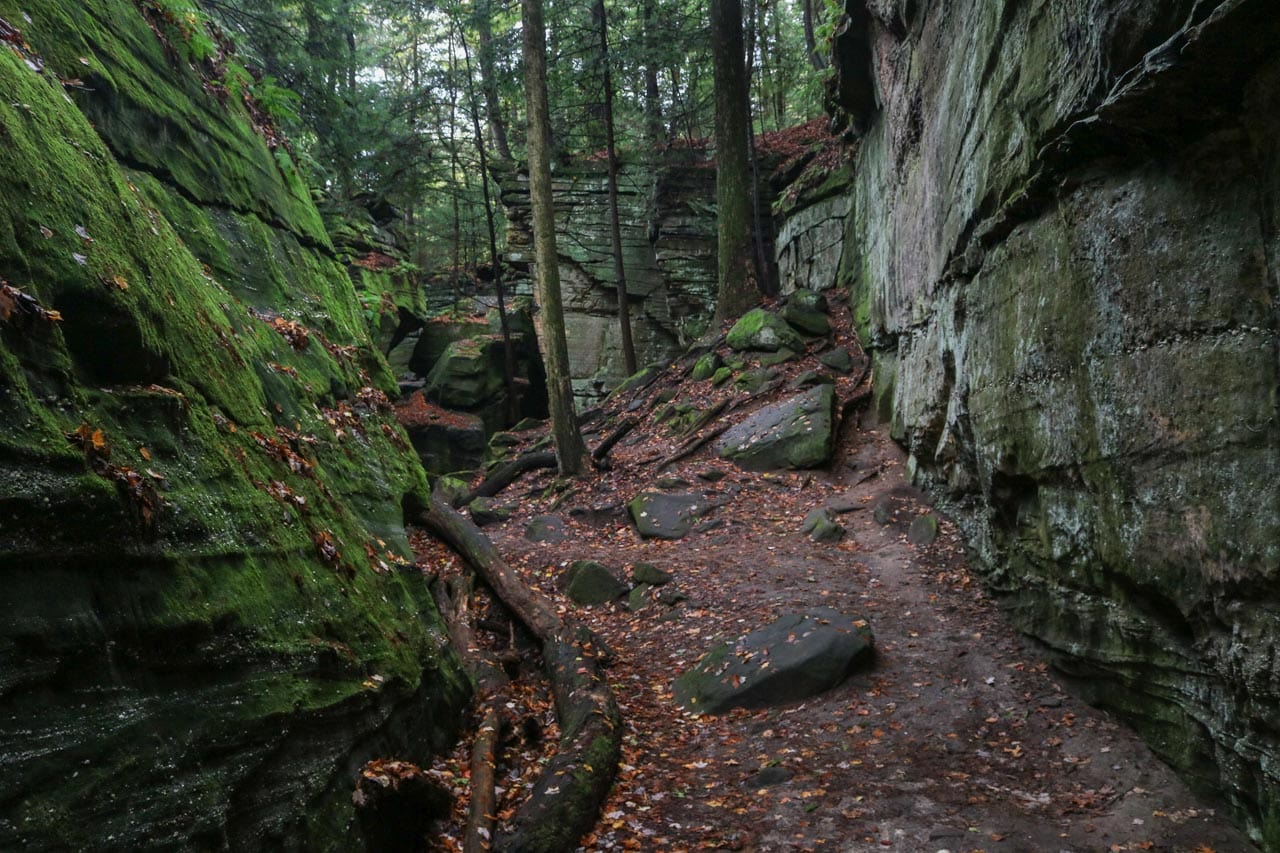
Probably the park’s most extraordinary geological landscape is The Ledges, also known as Ritchie Ledges. As early as the 19th century, this area attracted people who came there to hike and enjoy nature.
One of them was the industrialist Hayward Kendall, who went on the buy the entire area to create a public park. That park came to be known as Virginia Kendall Park.
Now situated within the national park, it still is one of the most popular attractions in Cuyahoga Valley National Park. Several hiking trails wind their ways through and around the area, allowing you to see its remarkable rock formations from up close.
During a day in Cuyahoga Valley National Park, you’ll only have time to hit one of them, though, if you’d like to see the other Cuyahoga Valley National Park highlights as well.
The best one is the 1.8-mile (2.9-kilometer) Ledges Trail that loops around, underneath and alongside tall moss-covered cliffs. This is one of the most atmospheric, if not mysterious, Cuyahoga Valley National Park trails. Don’t skip it!
3. Beaver Marsh

A day in Cuyahoga Valley National Park is not complete without a visit to Beaver Marsh. It’s easily the best place in the park for wildlife watching.
It may surprise visitors nowadays, but this site used to be an auto repair shop and was littered with rusty old parts and car wrecks. After the National Park Service acquired the land, a clean-up was organized in 1984, but there wasn’t a consensus on what to do with the land.
At the same time, after a century-long absence, beavers returned to the Cuyahoga Valley. They built a dam system that ended up completely flooding the area and creating an entirely new habitat—now known as Beaver Marsh.
The beavers are still around and often spotted, especially early in the morning. Other regularly seen animals include blue herons, turtles and even eagles. If you’re really lucky, you might even spot an otter frolicking in the water.
Beaver Marsh lies on the Ohio & Erie Towpath Trail (see below) and is easily accessible. A nice boardwalk runs across it, offering the best possible vantage point for wildlife spotting.
4. Blue Hen Falls
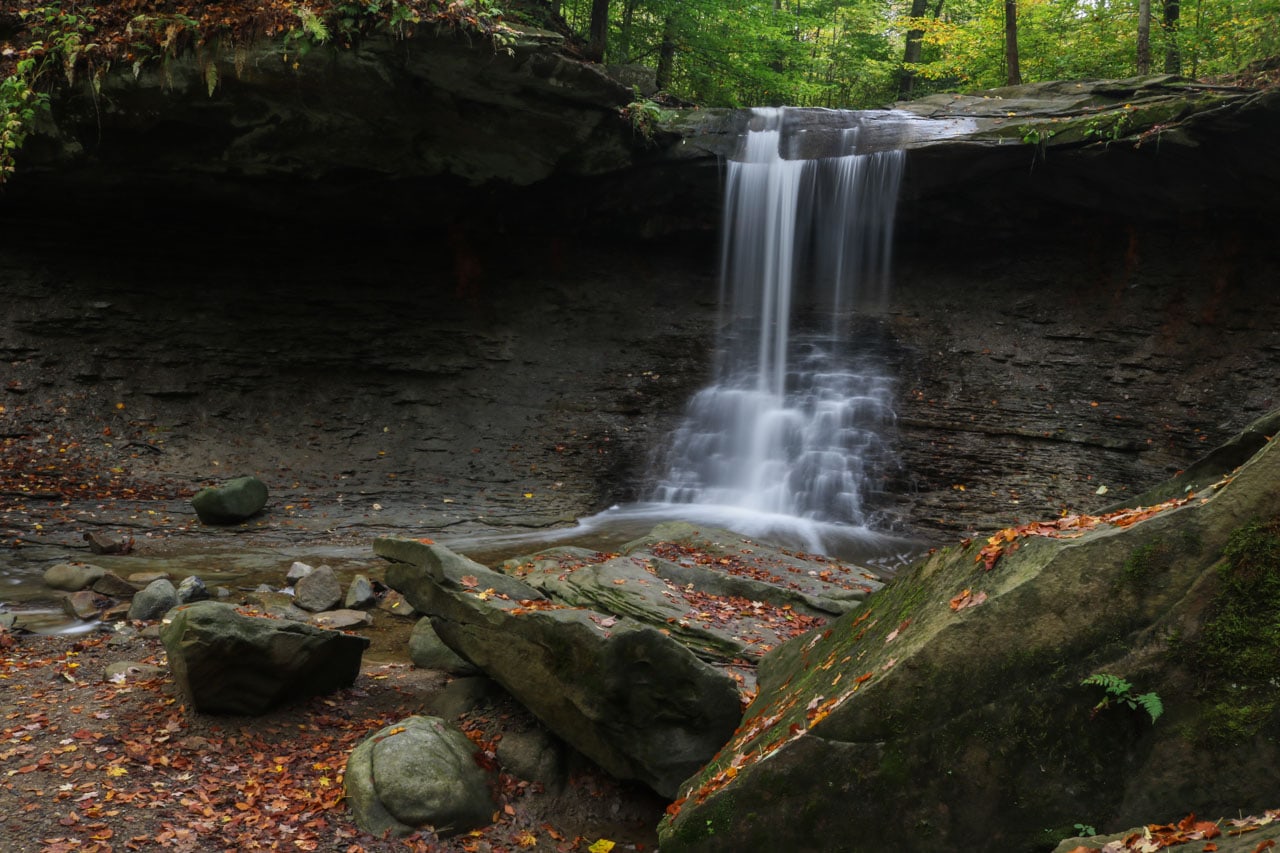
Although it’s not at all as large as Brandywine Falls, Blue Hen Falls does beat its bigger counterpart in terms of sheer beauty. No taller than 15 feet (5 meters), this beautiful waterfall is set amid a thick broadleaf forest and surrounded by rocks and boulders.
This was easily my favorite of all attractions in Cuyahoga Valley National Park—especially because it is so much quieter than popular Brandywine Falls.
The easy Blue Hen Falls Trail is only 0.2 miles (300 meters) long, but does not seem to attract that many visitors.
Except for the occasional brief visit by a family and the presence a couple of other photographers, I had the falls pretty much to myself. At Brandywine Falls, on the other hand, it was nearly impossible to take a photo without people in it.
So, therefore, when spending a day in the park, I advise you to see both main Cuyahoga Valley National Park waterfalls, but set aside more time for Blue Hen Falls than for Brandywine Falls.
5. Everett Covered Bridge
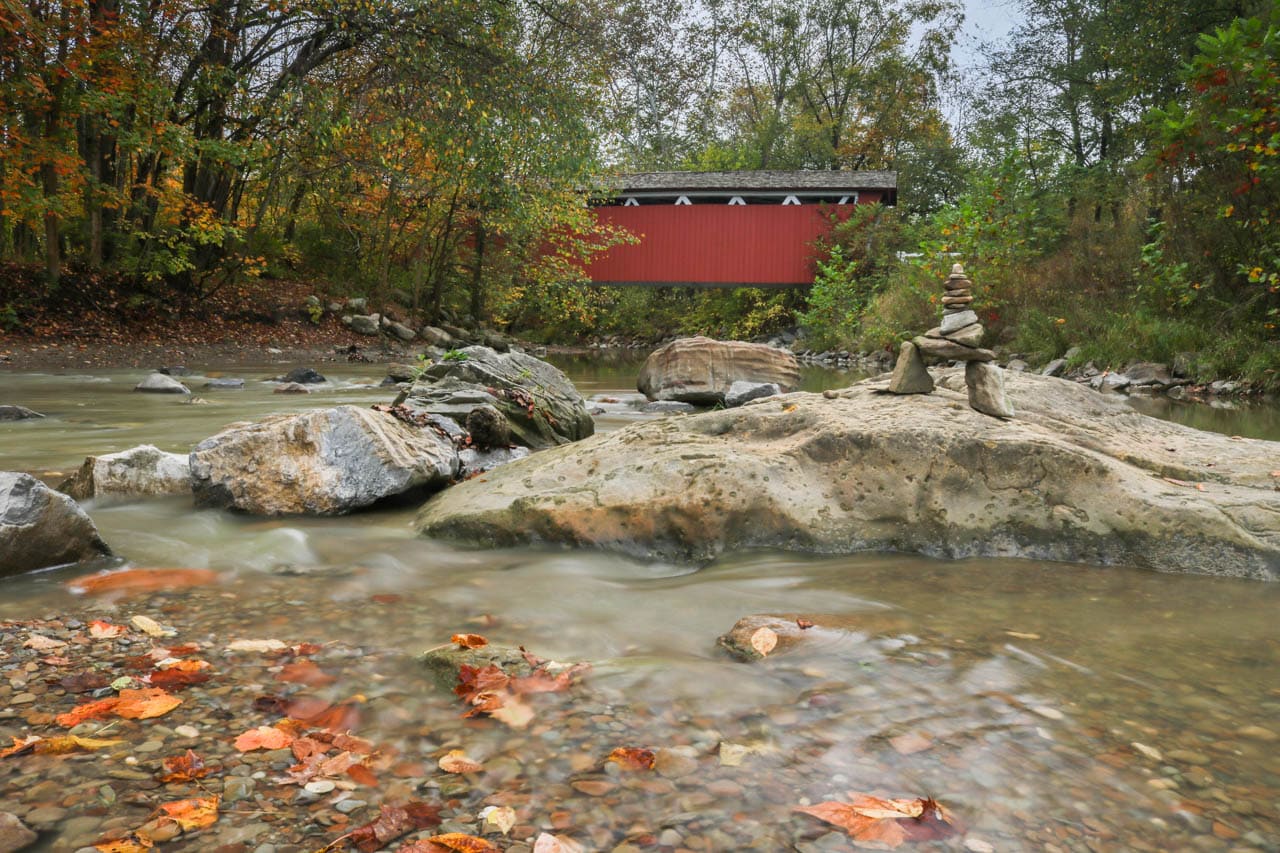
Another reminder of the 19th-century heyday of this area is the Everett Covered Bridge. It used to be one of more than 2,000 covered bridges in Ohio, which had the most covered bridges of any state in the U.S. at the time—as opposed to Vermont, which has the largest concentration of these picturesque bridges.
Nowadays, however, it’s the only remaining structure of its kind in Summit County. Still crossing Furnace Creek in the historic 1800s settlement of Everett, it is now only accessible on foot or bicycle.
Although it’s definitely a nice place for a quick stroll and to check off of your list, I wouldn’t recommend spending too much time there. Unless you’re a photographer, once you’ve seen it, you can move on.
I would, however, suggest taking the time to read the information boards you’ll see just before the bridge on your way from the parking lot. They offer an interesting insight into how this unlikely national park came about.
6. Cuyahoga Valley Scenic Railroad
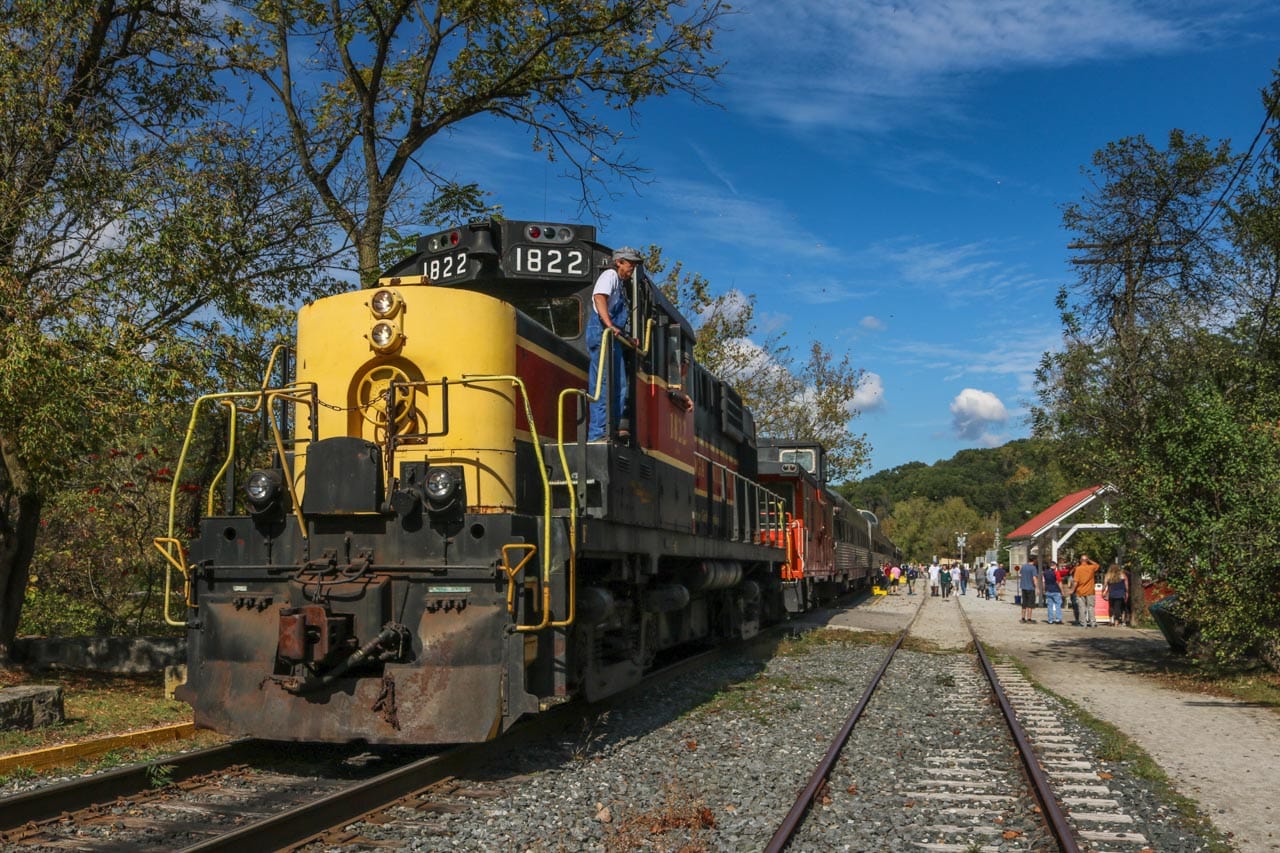
The Cuyahoga Valley Scenic Railroad is a testimony to the area’s industrial past. The Valley Railway started transporting coal from the Tuscarawas River Valley to the cities of Cleveland, Akron and Canton in 1880, also offering passenger transportation between those places.
Eventually, the railroad became an increasingly popular way to escape the city.
Automobiles and buses initiated the decline of the railroad in the early-20th century, but interest in this historic line sparked up again in the 1970s. In 1972, the Scenic Railway Association was established, now known as the Cuyahoga Valley Scenic Railroad.
The railroad is not operated by the National Park Service, but is a volunteer-supported non-profit organization. It runs between Rockside, just south of Cleveland, and Akron and the round trip is about 3.5 hours long.
You might say that the Cuyahoga Valley Scenic Railroad is the star attraction of Cuyahoga Valley National Park. It’s definitely the one attraction that sets the park apart from all other national parks in America.
I strongly recommend that you ride at least a section of it. The beauty of this railroad journey is that you can take your (rental) bike on board, allowing you to hop on and off at various stations along the way.
Foot passengers, on the other hand, can only board and disembark at three locations—Rockside, Peninsula and Akron.
Check the Cuyahoga Valley Scenic Railroad website for tickets, schedules and events. It’s a cliché, but this really is a “must-do” when visiting Cuyahoga Valley National Park.
7. Ohio & Erie Canal Towpath Trail
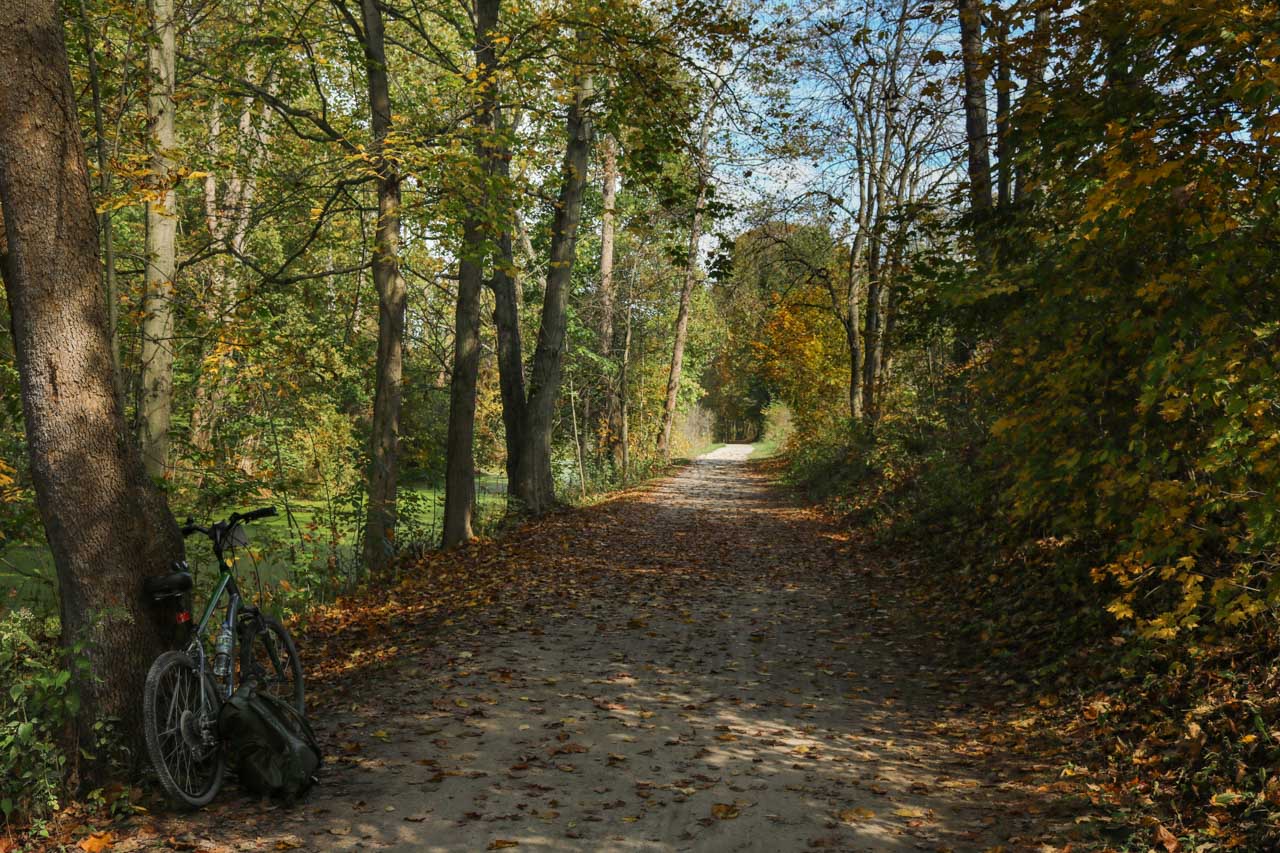
Just like the Cuyahoga Valley Scenic Railroad cuts through the park, so does the Ohio & Erie Canal Towpath Trail. In fact, both basically parallel one another, while also following the course of the Cuyahoga River.
Additionally, Riverview Road is a fourth transportation route that draws the same line through the park. So, there are four paralleling routes through the park. There is a railroad, a hiking/biking trail, a river and a road, which is pretty remarkable.
In the 19th century, the Ohio & Erie Canal connected America’s interior with the eastern seaboard, providing a huge new market for produce and products from the Midwest and the Great Lakes. The canal is long gone, but the Towpath Trail still follows its old course.
Now, you can hike and bike where mules once pulled canal boats. This scenic trail is absolutely gorgeous in fall and is one of greatest attractions in Cuyahoga Valley National Park. Together with the railroad, it symbolizes the park’s very essence.
The trail is accessible at numerous places throughout the park, paralleling the railroad and connecting to other trails.
I don’t suggest hiking this trail because I think you should focus on other/better Cuyahoga Valley National Park hiking trails, like The Ledges or Brandywine Falls.
However, I do recommend renting bicycles and exploring this beautiful trail on two wheels. It’s one of the best national park roads for cycling in the entire USA, after all.
You can find Cuyahoga Valley National Park bike rentals in the historic town of Peninsula, in the middle of the park. Conveniently, this town is also the location of a Cuyahoga Valley Scenic Railroad passenger boarding station.
Biking one way and taking the train back is one of the most fun things to do in Cuyahoga Valley National Park, Ohio.
Cuyahoga Valley National Park Visitor Centers
There’s one main visitor center in Cuyahoga Valley, as well as two other places housing exhibits.
Boston Store Visitor Center
The Boston Store Visitor Center in Cuyahoga Valley is the best place to start your day in Cuyahoga Valley. It’s open every day of the year, with the only exceptions being Thanksgiving, Christmas and New Year’s Days.
The visitor center lies conveniently along the Towpath Trail, while accessible parking is available in the parking lot of the Boston Store. This is a great place to stock up on information, such as guidebooks and maps of Cuyahoga Valley.
Address: 1550 Boston Mills Road, Peninsula, Ohio 44264
Canal Exploration Center
If you’d like to learn more about the history of the Ohio and Erie Canal, you should definitely visit the Canal Exploration in the north in the park. Also located along the Towpath Trail, this facility is fully accessible and has audio tours.
Address: 7104 Canal Road, Valley View, Ohio 44125
Hunt Farm House
Another fun stop along the Towpath Trail is historic Hunt Farm House, offering several family-friendly activities and exhibits.
Address: 2054 Bolanz Road, Peninsula, Ohio 44264
Accommodation Near Cuyahoga Valley
Situated so close to Cleveland and Akron, Cuyahoga Valley is literally surrounded by places to stay. From chain hotels around the park to B&Bs in historic houses in the heart of it, your options are virtually unlimited.
There’s a number of Cuyahoga Valley National Park camping options as well.
You can check out accommodation deals near the national park here.
Other National Parks to Explore
- Mount Rainier National Park Attractions
- Death Valley National Park Attractions
- Petrified Forest National Park Attractions
- Canyonlands National Park Attractions
- Acadia National Park Attractions
- Olympic National Park Attractions
- Olympic National Park’s Quinault Rain Forest Attractions
- Hot Springs National Park Attractions
- Joshua Tree National Park Attractions
- Shenandoah National Park Attractions
- Grand Canyon National Park Attractions
- Capitol Reef National Park Attractions
- Crater Lake National Park Attractions
- Arches National Park Attractions
- Theodore Roosevelt National Park Attractions







Thank you very much to provide the top attractions in Cuyahoga Valley National Park.
You’re welcome!
Such a detailed post! Thanks for sharing so much input and insight!
Cheers, Jade! I’m glad you liked it 🙂
Thank you for helping inform everyone about how awesome our little state is! I do have a small edit/update for you. Erie is not spelled with two E’s. The name comes from Lake Erie, which comes from a Native American Tribe that was located in the area. Thanks!
Hey Lindsey! Thanks so much for letting me know, I really appreciate it! 🙂
This is very nice , but my top recommendation would be Visit The Hale Farm!
At the Cuyahoga Valley’s southwestern edge sits an impressive three-story red brick house surrounded by 140 acres of fields, gardens, and woods.